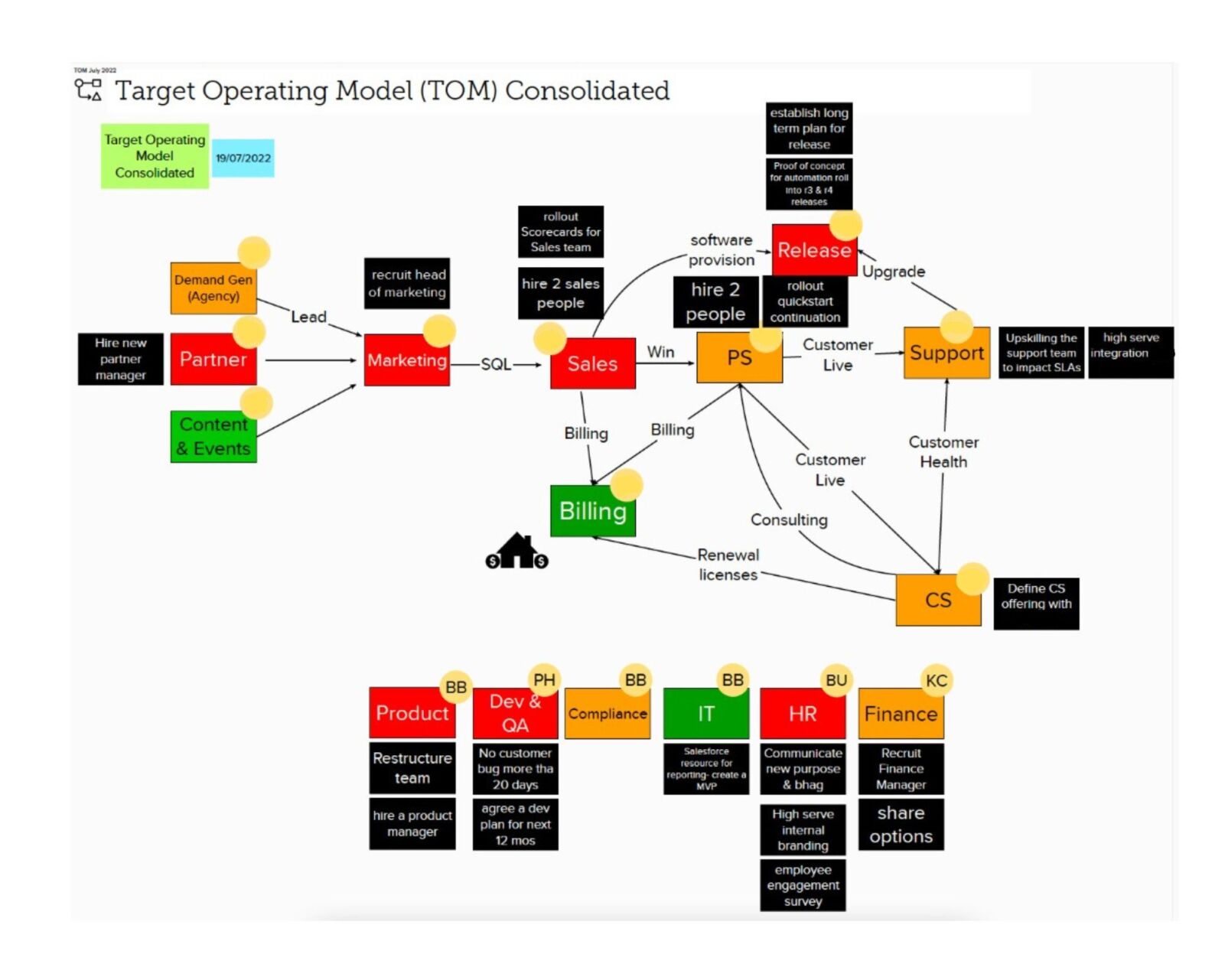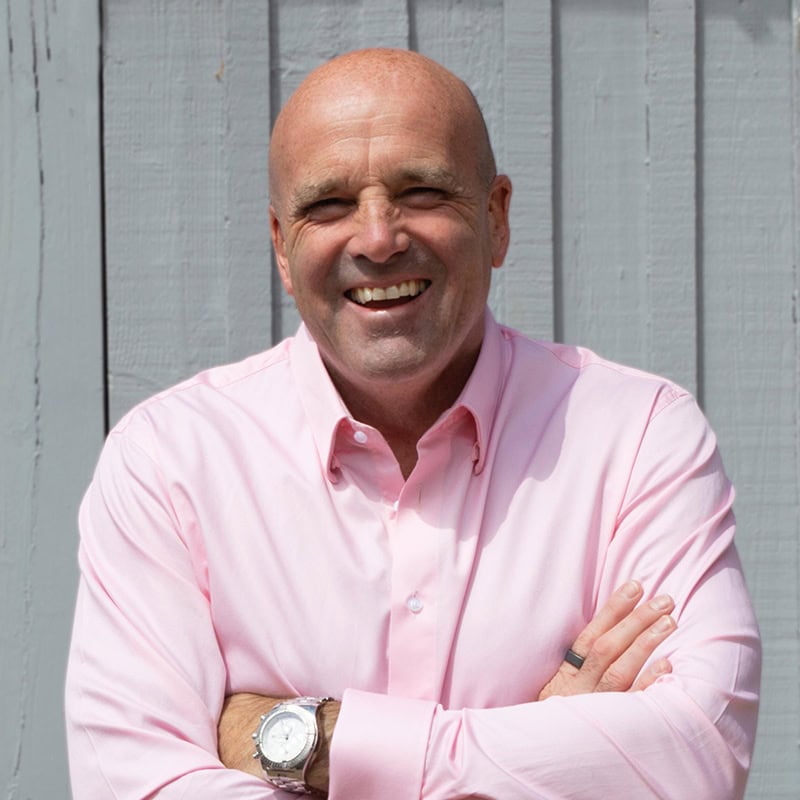Quick Summary
Priority Mapping turns your bold vision into focused weekly action, aligning your team and freeing you from firefighting and decision overload.
Takeaways
-
A clear vision is useless without a system to translate it into focused, actionable priorities.
-
Priority Mapping bridges the gap between strategy and execution by cascading goals from yearly to weekly.
-
Accountability only works when ownership is clear. Every key outcome needs a single, named owner.
-
Tools like OKRs and the Say/Do Ratio keep execution tight, focused, and bullshit-free.
Last week, I introduced the Founder Freedom Framework and its first accelerator, Vision Design. It showed how a well-designed vision gives your company clarity of purpose, rallying your team around why you exist and where you’re headed. But even with a bold vision in place, many founders still find themselves knee deep in shit – constantly realigning teams, fighting fires, and wondering why everything feels so bloody hard. This is where Priority Mapping comes in, the next accelerator in the Founder Freedom Framework.
Priority Mapping is all about translating that clear vision into concrete priorities from year to quarter to week, with ownership and accountability at every level. It bridges the gap between strategy and day-to-day action, ensuring everyone knows what really matters and how their work connects to the big picture.
It’s absolutely essential that you get this right if you’re to achieve your grand vision. It’s all well and good telling everyone that the destination for the road trip is Edinburgh, but if they don’t know whether they turn left or right out of the driveway, getting there is going to be hell on earth.
In this blog, I’ll explore how Priority Mapping works and why it’s essential to freeing founders from daily operations. I’ll cover how to cascade long-term goals into actionable priorities, how to use tools like OKRs effectively, and how to build a rhythm of accountability so nothing falls through the cracks. By the end, you’ll see how Priority Mapping turbo-charges execution – keeping your team aligned and focused, and keeping you out of the daily grind.
Why the strategy-execution chasm is killing your growth
A clear vision is brilliant, but how the hell do you know if everyone’s actually rowing in the same direction every day? Most companies suffer from a painful gap between vision and execution—lots of fancy plans, zero practical impact. Teams nod enthusiastically at the annual offsite, then immediately go off and spend weeks doing stuff that doesn’t actually matter.
Symptoms include drift, friction between teams, fatigue from conflicting initiatives, and employees investing time in low-priority projects. In short, clarity gets lost in translation. Priority Mapping solves this by creating a line of sight from the Big Hairy Audacious Goal (BHAG) to this week’s to-do list.
The process starts with your high-level strategy. In Vision Design, you defined your purpose, BHAG and perhaps a handful of strategic thrusts or pillars – the 3-5 big things that must go right for you to hit your long-term goal. Priority Mapping takes these strategic thrusts and turns them into an actionable roadmap. Think of it as strategy on one end and execution on the other, with Priority Mapping building the connective tissue between them.
Priority Mapping, in essence, is about focus. It forces you to choose what not to do. You can’t pursue ten priorities and expect to succeed; you need a few that matter most. After nailing your Vision, you set your top 3-5 differentiating strategies or pillars. From there, you ask: Given our 3-5 year plan, where do we need to be by this time next year? Define no more than five key objectives for the year, and under each, define measurable Key Results to gauge progress. This framework is known as OKRs – Objectives and Key Results. It was pioneered by Andy Grove at Intel and later popularised by Google, and it’s a fantastic tool for Priority Mapping because it ties ambitious objectives to concrete outcomes.
Ownership and accountability at every level
One big reason founders get sucked back into day-to-day firefighting? No bugger knows who’s accountable for what. The company grows, silos spring up everywhere, and suddenly the founder’s back to being Chief Problem Solver. Priority Mapping kills this nonsense stone-dead by locking in crystal-clear ownership for every key metric and activity.
We use tools like the Function Accountability Chart or a Target Operating Model (TOM) to map all the critical functions and processes in your company – from Marketing and Sales to Customer Success, Finance, IT, etc. – and assign an owner to each. This isn’t about job titles or who reports to whom; it’s about who is accountable for the outcomes of each function. As I often tell clients, responsibility can be shared, but accountability must be singular. Someone has to have their name on each major area, so the buck stops somewhere.

The Target Operating Model is particularly handy for this. It lays out your “quote-to-cash” value chain and all supporting functions. Then, as a team, you RAG-rate each function (Red, Amber, Green) to assess its current health. Importantly, you do this rating collectively – not letting each department head self-report that their area is “all green” while others nod politely. This exercise surfaces interdependencies and forces the team to confront reality together. Once everyone agrees what’s red or amber, those become the team’s priorities – fix the reds. And anything green? You stop wasting time talking about it.
Now, how do we fix the reds? Through tactical priorities and actions – often formulated as OKRs or specific projects. For each red or amber area in the TOM, the team asks: what exactly are we going to do in the next quarter to improve this? These actions become your short-term priorities. This is Priority Mapping in action: using a high-level model to focus the team on what matters most, then cascading actionable objectives to the people who will drive them.
Crucially, once priorities are set and owners assigned, the founder must step back and let those owners drive execution. Your job becomes holding them accountable in a healthy way, not micromanaging or solving it for them. Every priority has an owner, and that owner reports on progress regularly. If a priority is slipping, the question isn’t “why haven’t I fixed it yet?” but rather “what do you (owner) need to get this back on track?” By creating this clarity, founders liberate themselves.
The say/do ratio: Simple accountability that works
A quick note on tools that reinforce accountability: I strongly advocate the “Say/Do Ratio.” Here’s how it works: each team member makes one concrete commitment each week – the one thing they will get done that directly advances a key priority. In the next weekly meeting, they simply say “yes” or “no” – did they do what they said? No lengthy excuses or blame games; it’s a binary answer. You track each person’s yes/no over time. This simple practice shines a light on execution reliability and creates a culture where there’s nowhere to hide.
Turning big goals into weekly priorities (The OKR cascade)
Let’s cut through the bullshit on OKRs. Your Objective is simply the big thing you want to nail—think qualitative and inspiring. Key Results are your scoreboard—the specific, measurable things that, when ticked off, prove you’ve actually smashed it. For example, your objective might be ‘Delight our customers,’ with a Key Result like ‘Boost NPS from 45 to 60 by year-end.’ Easy.
We start at the top: annual Objectives for the company. These should link back to your vision and strategic thrusts. Limit these to 3-5 company-wide objectives for the year – enough to cover the essentials, but few enough to maintain focus. Each objective gets 2-3 Key Results that make it concrete.
Once the leadership team agrees on the annual OKRs, cascade them down. What does each department need to accomplish this quarter to contribute to the yearly goals? This cascading should be iterative. I encourage involving all levels of the organisation in OKR setting – leadership sets the direction, teams and individuals can then suggest their own OKRs that support those goals. When people are part of setting their targets, they’re more committed to delivering them.
Through Priority Mapping, by the time you get to individual weekly tasks, everything traces back up to the big goals. Every Monday, each team member should know: These are my top priorities this week because they feed into our quarterly targets, which feed into our yearly goals, which realize our vision. It’s a golden thread of alignment.
Leading vs lagging indicators: Measure today what tells you about tomorrow
A common pitfall is focusing too much on lagging indicators (outcomes) instead of leading indicators (inputs you can control). Stop obsessing about lagging indicators—revenue, EBITDA, market share. Sure, they’re important, but they’re yesterday’s news by the time you see them. What you really need are leading indicators: the stuff you can actually influence today that reliably tells you what’s coming tomorrow. Nail these, and you’ll stop steering the business by looking in the rear-view mirror.
For example, revenue is a classic lagging indicator—you can’t just wave a magic wand and boost it today, can you? But you can control things that drive it, like sales-qualified leads (SQLs). Say historically each new client needs 3 SQLs. If you need 10 new clients next month, that’s 30 SQLs—or roughly 7-8 a week. If it’s Wednesday and you’ve only got 2, it’s immediately clear you’re off track, and you’ve still got time to sort it out. That’s the kind of thing you can focus on and fix – if you’re only looking at revenue then the problem will be out of control by the time you know about it. You’ll be shutting the stable door not only after the horse has bolted, but after it’s been melted down for glue.
Founder freedom through focus and rhythm
Priority Mapping might sound involved – and yes, it requires some upfront work to get your plans and metrics sorted – but the payoff is huge. By driving clarity on priorities, owners, and metrics, you create an organisation that executes smoothly without you having to drive every detail. Your job shifts to designing the system and then tending to it.
When vision and priorities aren’t crystal clear, the founder inevitably becomes the backstop – constantly re-explaining the direction, reasserting what matters, essentially fighting the same fires over and over. That’s exhausting and it doesn’t scale. Priority Mapping is your way out. It gives your team the tools and clarity to run the business without leaning on you for every decision.
Priority Mapping isn’t a onetime task; it’s an ongoing discipline. Every quarter you refine your priorities, set new OKRs, and adjust based on what you learned. I know what you’re thinking: “Great, more bloody admin. Thanks a bunch, Dom.” But once this becomes habit, it doesn’t feel like a burden – it actually lightens the load. The framework does the heavy lifting of keeping everyone honest about what’s important.
We’re gearing up to formally launch the Founder Freedom Framework, and Priority Mapping is just one part of it. These accelerators aren’t standalone hacks—they’re connected, layered, and designed to scale together. Vision Design gives you clarity on where you’re headed. Priority Mapping gives you the discipline to get there without the chaos. Nail these two and you’ve already solved the biggest headaches founders face between 30 and 100 people: lack of alignment and lack of focus.
Next up? The accelerators that help you stop firefighting, build a high-performance team, and get out of the way. So stick with me. And in the meantime—keep the priorities sharp, the accountability tighter, and the say/do ratio sky-high. That’s how you go from running everything to running a business that runs without you. That’s founder freedom.
Written by business coach and leadership coaching expert Dominic Monkhouse. You can order your free copy of his book, Mind Your F**king Business here.

